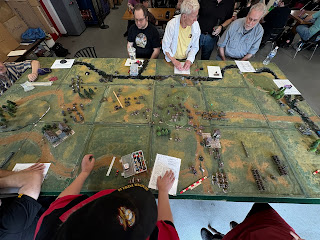 Once a quarter during the Centurions gameday at the Source Comics and Games we play Koenig Krieg, version 1.5.
Once a quarter during the Centurions gameday at the Source Comics and Games we play Koenig Krieg, version 1.5.
“Koenig Krieg” was originally published by Barry Gray in the mis 1980’s. In 1996 Tom Dye edited the rules and republished the rules with Outland Games. Our group refers to this as version 1.5. The Centurions have been using this version of “Koenig Krieg” since the early 2000’s and have played hundreds of games. It is one of the clear cut favorites of our group, along with “Field of Glory” and “Regimental Fire & Fury”.
Our latest game had 10 players, seven cavalry brigades and thirteen infantry brigades along with associated artillery and light infantry. These numbers are typical of the favorite rule sets but by no means the largest game we have played.
The French were deployed along a fordable stream with two brigades of cavalry on each flank and six brigades of infantry in the center. The river on the right hand side of the board is not fordable.
With three brigades of cavalry on the left flank and three brigades of British and Hanoverian infantry on the right, they were supported by four brigades of DUTCH infantry on the extreme left.
The overall British Plan, personally approved by King George, was for the British cavalry on the left to move forward, engage the French cavalry on that flank, while the center British Infantry moved forward to hold the French Infantry in the center and the Hanoverians held off the French right flank while the Dutch slammed headlong into the flank of the French driving towards the center of the board.
Initially the French planned on fighting a delaying action allowing the British and her allies to come to it. Lt. General Tony on turn one got his dander up and launched an attack towards the intersection of the British and Hanoverian Infantry.
The aggressiveness of the French caught the British and Dutch players off guard a bit. As General Bob noted, without the Dutch allies the British and Hanoverians were out numbered 9 Brigades to 6 Brigades.
On turn two the British cavalry slammed into the French cavalry on the British left flank. The superior morale of the British cavalry allowed the British to pull out a narrow win, but even in a win it was costly for the small British heavy cavalry regiments as they took winners casualties. In the aftermath of the melee, during the exploitation phase the British lost control of one Cavalry regiment and the other two regiments ended up in a bad location.The British in the center ended up forming a salient, the Cavalry on the left flank was joy as affective as they hoped and the aggressive movements turned their plans from a holding the French to a full out defensive posture.













No comments:
Post a Comment